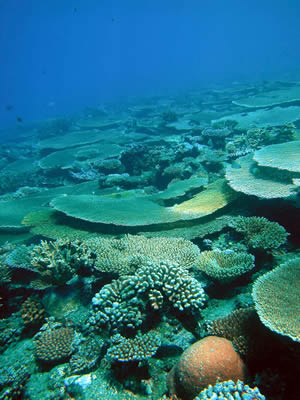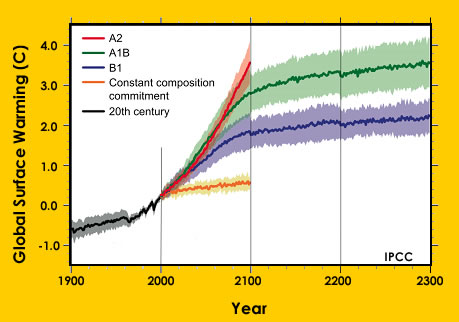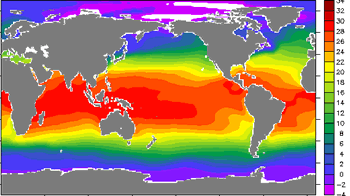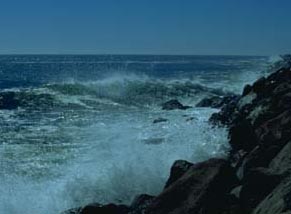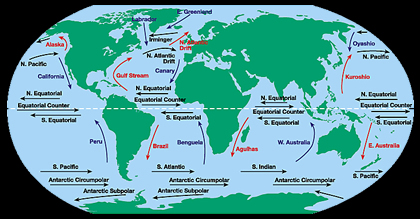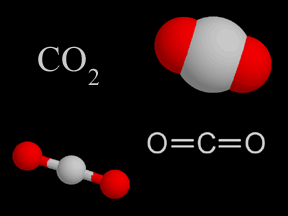Click on image for full size
Credit: UNC
Natural Ocean Thermostat Helps Protect Pacific Ocean Coral Reefs
News story originally written on February 7, 2008
While corals thrive in warm, tropical water, water can get too warm for their liking. As our planet’s climate changes, the oceans are becoming warmer, which could be bad news for coral animals. However, new research suggests that natural processes might stop areas of the ocean from warming too much for corals to survive. If so, then some of the world's largest coral reefs might be protected from climate change.
The temperature of tropical waters has increased about 0.5 to 0.7 degrees Fahrenheit (0.3 to 0.4 degrees Celsius) over the last 20 to 30 years, and temperatures sometimes spike higher. Reefs in areas of the tropics where water temperature has risen have been vulnerable to bleaching, a condition where coral animals loose the algae that live within their little bodies. These algae normally provide corals with some nutrition. Without the algae, bleached corals are less healthy. Unless cooler temperatures return, allowing algae to return, the bleached corals die.
While the temperature of seawater in many tropical areas has risen over the last few decades, an area in the Pacific Ocean northeast of Australia, called the Western Pacific Warm Pool, has not changed much. The reefs in this area have remained healthy and not suffered much bleaching.
A team of scientists, led by Joan Kleypas of the National Center for Atmospheric Research and including scientists from the Australian Institute of Marine Science, studied the Western Pacific Warm Pool in the Pacific Ocean. They analyzed records of sea-surface temperature measurements, coral bleaching reports, and they used a climate model called the NCAR-based Community Climate System Model to study simulations of past and future sea-surface temperatures.
They found evidence that the temperature of seawater might be kept in check by natural processes. Sea-surface temperatures in the Western Pacific Warm Pool naturally average about 85 degrees Fahrenheit (29 degrees Celsius). The waters have warmed up only about half as much as cooler areas of the ocean.
Between 1980 and 2005, only four episodes of coral bleaching have been reported for reefs in the Western Pacific Warm Pool. This is less bleaching than other reefs have had, even though the western Pacific reefs appear to be especially sensitive to temperature changes.
Their research supports the hypothesis that natural processes may prevent sea-surface temperatures from becoming warmer than about 88 degrees Fahrenheit (31 degrees Celsius) in open oceans. Researchers have speculated about several processes that could regulate ocean temperatures. For example, as surface waters warm, more water evaporates and the process of evaporation removes heat. Evaporation can also increase cloud cover and winds that cool the surface. In some areas, warming alters ocean currents in ways that bring in cooler waters. If these processes prevent water from warming, reefs in the Western Pacific Warm Pool might remain healthy. However reefs in other regions of the world may not be so lucky. Even if there is a limit to seawater warming, reefs that live in slightly cooler waters will experience much more temperature change as their waters warm towards the limit, and the temperature change causes bleaching.
"Climate change is damaging many corals, but it appears to be bypassing certain reefs that support some of the greatest diversity of life on the planet," says scientist Joan Kleypas. "In essence, reefs that are already in hot water may be more protected from warming than reefs that are not. This is some rare hopeful news for these important ecosystems."
In addition to warming seawater, coral reefs face many other threats. Overfishing is reducing diversity and the number of grazing fish that keep algae populations in check. Coastal development can add sediment to reefs, blocking sunlight and preventing reef creatures from feeding. Pollution of ocean waters affects reef health and changes to ocean chemistry caused by rising levels of carbon dioxide are causing reefs to become more acidic.
"Warming waters are just one part of the picture, but they are an important part," says Joan Kleypas.


